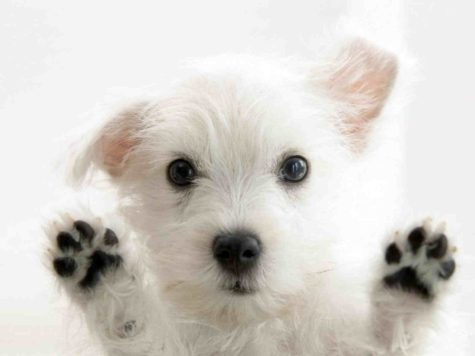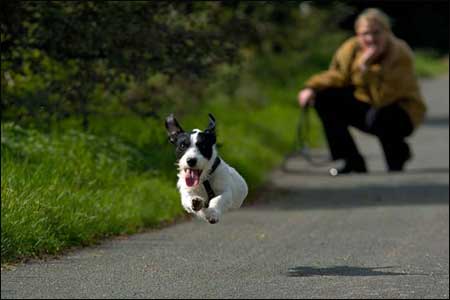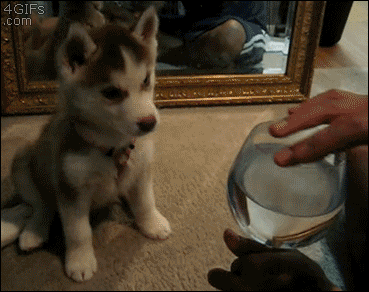Getting Started
Puppy Training – The Basic Principles
A puppy learns through – Consistency and repetition.
 This requires:
This requires:
- Patience
- Persistence
- Confidence
- Follow through
- TIME
You will also need – Knowledge of your puppy’s temperament, an understanding of canine behavior, and a balance of rewards and consequences.
Crimes and Corrections / Praise and Discipline:
- The reward for “good” behavior must outweigh the pleasure gained from the “bad” behavior.
- The correction must override the will of the puppy to continue with the “bad” behavior, without overwhelming the will of the puppy to make decisions.
- The puppy’s confidence in naughtiness must be shaken, and at the same time, the puppy’s confidence in self, and in you, must remain strong.
- An understanding of why your puppy is doing a particular thing can be very helpful, also take into consideration how your puppy reacts to his senses.
- Puppies are motivated by pleasure, pain, fear, and also by their assessment of their place in the family or pack.
- Dogs and puppies have a strong need for leadership. If you cannot take on the role of leader, your puppy will.
Remember:
Everything that happens to a puppy happens right now. Praise and correction must be handed out during or immediately following the behavior or your puppy will not get the message you are trying to get across.
Written by: Shirley Gibson
Note:
You are welcome to share this post but ONLY IF you give credit and a link back to Teach Your Dog To Behave or shirleytwofeathers.com.
Training Do’s and Don’ts
All dogs (unless physically handicapped) see and hear and have feelings, so your first concern should be from your pup’s point of view. One very good way to consider him is to form one especially important habit right now. If you smoke, never do it while training or playing with your Buddy. A hot ash, accidentally dropped in his eye could cause irreparable damage.
Your body can be a towering mass for your pup to fear, or, as we hope, it can be his security and something to love. In training, try to visualize everything from his point of view. Therefore, instead of bending over so that you still tower over him, it’s much better to squat down and let him see you at the same level he is.
Be careful, too, about how you use your eyes. As crazy as it may seem to you, they can be very upsetting to your pup. Never stare at your Buddy; look over his head or to one side of him. Don’t forget that your intentions are transmitted to your pup in many ways, sometimes even in ways that we cannot fathom or explain to our own satisfaction. The bond that develops between the two of you is a great fulfillment and should not be dealt with lightly.
A list of ‘Do’s’ for training:
- Teach only what you understand.
- Follow any correction with praise and work.
- Work with your pup as a team.
- Wear quiet, comfortable shoes when training.
- Wear clothing that does not interfere with your pup.
- Stop your training before losing your temper.
- Be consistent with your training, at home or in class.
A list of ‘Don’ts’ for training:
- Correct by slapping with a lead.
- Correct if you are not positive your pup fully understands.
- Be a show-off with your training.
- Over train.
You know your dog-work WITH him. Don’t confuse him with sudden drastic changes. Avoid resentment as well. Practice. Practice. Practice. Take nothing for granted.
-excerpts from
The Pearsall Guide to Successful Dog Training
by Margaret E. Pearsall
Getting started with Dog Obedience Training
This was my standard handout for dog obedience classes.
You will need:
- Time – 1 hour a day
- Patience
- A sense of humor
- A strong desire to succeed
Training Collar:
- Sometimes called a “chain” or “choke” collar
- To insure a proper fit, the collar should slide easily, but not loosely, over your dog’s head. A training collar that is too loose will not work properly.
- Choose one with wide links – training collars made with thin narrow chains tend to cut into the dog’s neck.
- Don’t skimp on quality when choosing a training collar, pick a brand that is guaranteed against rust and breakage.
Regular Collar:
- If you have a shy, timid, or very small dog, we may decide to use a leather collar for training.
- Should fit tightly enough that only 2 fingers will fit between the collar and your dog’s neck. This is a safety precaution. If the collar is too loose and your dog balks or backs up, a loose collar will slide over your dog’s head and come completely off.
Other Collars:
- Depending on the situation, the size, sensitivity, and temperament of your dog, we may recommend the use of a ‘pinch’ or ‘prong’ collar for training.
- Small dogs and puppies that are shy, timid, very young, or very submissive may be started with a leather collar. It should fit tightly
enough that the collar cannot accidentally slip off your dog’s head. - Nylon slip collars will not be practical for training as they have a tendency to get caught in long hair, will heat up with repeated use, and often do not release properly
Leash:
- Retractable leashes and chain leashes are not practical for training.
- It is very important that your leash be six feet long. A four foot long leash will not be long enough to teach ‘stay’ and ‘come.’
- Leather is better, but nylon or cotton will do just fine.
- When choosing a leash, find something that feels comfortable in your hands. Something light and thin will be fine for small dogs, but if you have a large out of control dog, you will want a leash that will not cut into your hands.
- A good clasp is very important if you have a big strong dog, or a dog that pulls hard on the leash.
Training Area:
- When teaching your dog something new, choose a place to work with your dog where there is a minimum of distractions.
- When practicing commands that your dog already knows, choose a place with many temptations and distractions so that you can reinforce the training.
- A large area is nice, but all you really need is enough room to walk with your dog at your side.
- As soon as your dog knows and understands a command, begin to use it as part of your dog’s daily life. Do not, however, overwhelm your dog with obedience, especially in the beginning.
Treats:
- For puppy classes, treats are a great asset, but for the basic obedience training, I do not recommend the use treats as part of the
training. - This is because too often the dog learns right away to only perform if there is a treat involved.
- When dogs are stressed or nervous, when they are excited about new sounds and smells, when there is the distraction of other dogs and new people, or if your dog is timid or shy, they are not the least bit interested in even the most savory of treats.
- Also, the goal is for the dog to obey you, and listen to you because they love and respect you, not because there’s something in it for them.
Written by: Shirley Gibson
Note:
You are welcome to share this or use it in your own classes, but ONLY IF you give credit and a link back to Teach Your Dog To Behave or shirleytwofeathers.com.




